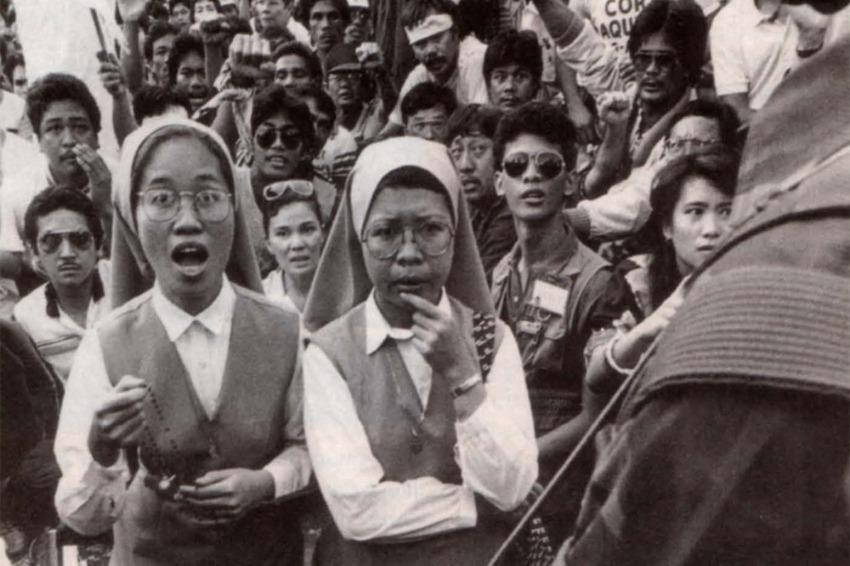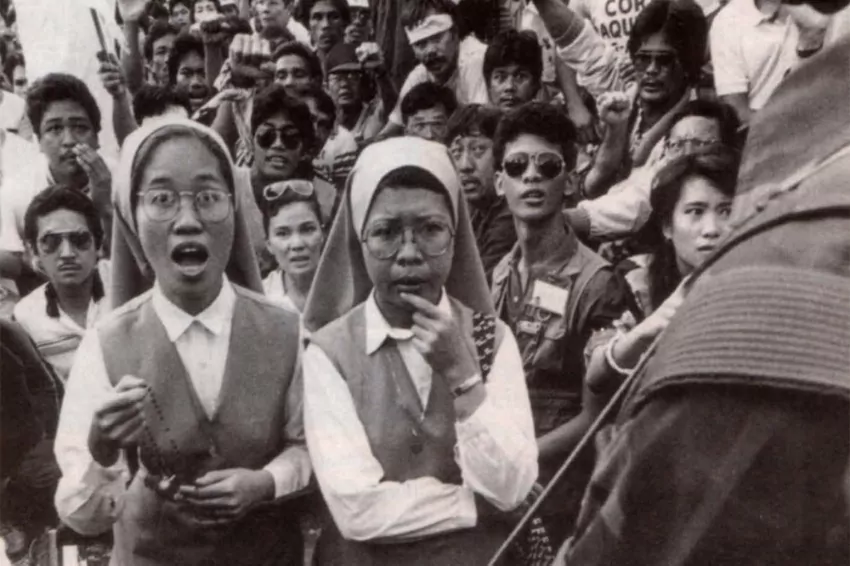

(c) Positively Filipino
According to an interview with Rappler conducted by an assistant professor at the University of the Philippines, the nuns who sheltered former President Corazon Aquino in 1986, while she was running for president at the time, did so to demonstrate “unity” against the dictatorship.
Karlo Mongaya made this statement during Rappler’s Voices from the Region program on Saturday, August 20. “It’s a really significant historical moment because you have here the religious community intervening in a political, very critical political situation so yeah that was really important and it showed that the unity of different sectors, from the church hierarchy, you have the traditional politicians who were fed up of the dictatorship,” Mongaya said.
What exactly Cory Aquino did with the Carmelite sisters on the evening of the People Power Revolution in 1986 has become a topic of discussion since the trailer for the film Maid in Malacanang inaccurately presented the nuns as playing mahjong with Aquino.
The video is not based on any of the dozens of authentic historical records that are available; rather, it is based on the dubious story provided by Senator Imee Marcos.
According to a statement released on August 2 by the prioress of the Carmelite Monastery, Sister Mary Melanie Costillas, “The fact was that we were then praying, fasting, and making various types of sacrifices for peace in our country and for the people’s decision to prevail.”
The nuns who were with Aquino on that night in February 2016 and who were questioned by Rappler stated that they permitted Cory to enter the cloister because they acknowledged her as the “rightful” president of the Philippines.
Aimee, the Mother Superior of the Carmelite Order, exercised her power at the time and permitted a non-Carmelite priest, nun, or layperson to enter the papal enclosure without first obtaining permission from the Pope. This level of discretion is customarily accorded solely to the heads of state.
When the trailer for the movie was posted online, Mongaya expressed his opinion that it was “disrespectful” to show the nuns as playing mahjong. He said this after the trailer was made available online.
“Well, I thought it was incredibly insulting and even our leaders, politicians, who are in reality aligned with the current regime, I think they share the same attitude,” Mongaya added. “Well, I thought it was really disrespectful and even our leaders, politicians.”
“Simply because this is your politician that you support does not give you the right to take liberties with the truth and with historical facts,” I said. “It’s not just because this is your candidate that I support. Therefore, it is an extremely rude act. When you campaign for a candidate, one of the things you might want to do is tell people things about that candidate or about their perspective on the situation. It’s one thing to have the facts wrong about the past, but quite another to denigrate the people who lived there,” he continued.
However, the anti-Marcos feeling that existed in 1986 did not emerge out of nowhere.
According to Mongaya, the killing of opposition leader Ninoy Aquino on August 21, 1983 had sparked large rallies and resistance against the dictatorship.
After the assassination of Senator Aquino in Cebu, Mongaya observed, “But from that point on, we could feel a subterranean difference.”
He stated that even though there was already a rising protest movement, the widespread unity that was developed as a result of his murder was between traditional politicians, mass groups, and young people.
The academic continued by saying, “Mas nangisog ang kining mga traditional politicians and kining mga sectors, they were now linking their issues to the national and political stage.” This phrase can be translated as “The traditional politicians have become angrier and stronger, and different sectors are now linking their issues to the national and political stage.”
Cebu was not immune to the disillusionment that occurred with the government that emerged after the Marcos regime and its failure to implement meaningful democratic reforms. Although the killing of Aquino sparked resistance and protests in the province, Cebu was not immune to this despair.
Despite the fact that it has been almost 36 years since Cebu became recognized as an opposition bailiwick, the people of the province of Cebu chose Ferdinand Marcos Jr. as their candidate for president in the election of 2022.
As Mongaya saw it, “You have the machinery, you have the architecture of network deception, you have all of the traditional politicians standing up with the government picket,” and “that was really the formula for a great success especially in Cebu which was once an opposition bailiwick.”
Gwen Garcia, the popular incumbent governor of Cebu, and her One Cebu party, which is the preeminent political force in the country’s most vote-rich province, provided support for the Marcos-Duterte campaign.
But Mongaya said that the opposition to the administration of current President Ferdinand Marcos Jr. can learn from the experiences of the activists who fought the dictatorship of his father. This is despite the fact that the opposition may face difficulties as a result of the administration of the current President.
“One of their favorite phrases that they really chant in the streets is this: ‘Makigbisog, ayaw kahadlok,’ which can be translated as either ‘Do not be scared, dare to struggle,’ or ‘Do not be afraid, dare to struggle.’ And I think that is one of the most important principles that we should hold on to today because during their time, you really needed to have the courage and the audacity to try to change things because that was under a dictatorship,” the history researcher said. “And I think that is one of the most important principles that we should hold on to today.”
The second thing that we should take away from this, he continued, is to remember Marcos Jr.’s campaign motto, which was “create unities.”
“Another thing would be, this is also the story of the protest movement in Cebu, that’s the necessity to develop unities, and it’s important to do so. The urban poor, the basic Christian communities formed by the Church, and the student movement were the ones who started the protest movement in Cebu after Marcos declared martial law,” Mongaya stated.
“But in the end, they were forced to establish unity across a wide range of challenges that were being faced by diverse sectors because they were facing a single scenario that was authoritarian in nature… As a result, they constructed a broad united front. This front eventually became powerful enough to be able to overcome the repression of the Marcos dictatorship, and that was the culmination, the People Power [Revolution],” he added. This event was the culmination of the People Power [Revolution].
HYCO1 and Malaysia LNG (MLNG) teamed up through a memorandum to establish a revolutionary carbon capture and utilization plant in…
OpenAI has released a significant update to ChatGPT, a big leap toward online shopping revolution. Starting this Monday, the new…
The All Blacks have a tough week, with Anton Lienert-Brown and Mark Telea suffering setbacks which will affect Super Rugby…
British-Filipino alt icon beabadoobee is coming home to Manila on her Asia Tour 2025. Be sure to save the date,…
In a unique melding of old spirituality with new technology, Johor's Tianhou Temple claims to have the first-ever Mazu statue…
Former DIA member Somyi is returning to the hallowed halls of K-Pop following legal troubles and a bitter stint in…
This website uses cookies.
Read More